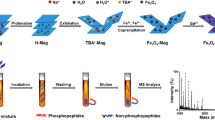Abstract
Development of affinity materials for the selective enrichment of phosphopeptides has attracted attention during the last decade. In this work, diamond-lanthanum oxide and diamond-samarium oxide composites have been fabricated via the hydrothermal method. The composites are characterized by scanning electron microscopy (SEM), energy dispersive X-Ray spectroscopy (EDAX), and atomic force microscopy (AFM). The analyses confirm the size and composition of the nanocomposites. They have been applied to selectively capture phosphorylated peptides from standard proteins (β-casein and BSA). Selectivity is calculated as 1:3000 and 1:1500 while sensitivity down to 1 and 20 fmol for diamond-lanthanum oxide and diamond-samarium oxide nanocomposites, respectively. Enrichment efficiency has also been evaluated for non-fat milk digest where 18 phosphopeptides are enriched. Total of 213 and 187 phosphopeptides are captured from tryptic digest of HeLa cells extracted proteins by diamond-lanthanum oxide and diamond-samarium oxide, respectively. Finally, human serum, without any pre-treatment, is applied and nanocomposites capture the endogenous serum phosphopeptides.

Capture of phosphopeptides through nanocomposites





Similar content being viewed by others
References
Li Y, Zhang XM, Deng CH. Chem Soc Rev. 2013;42:8517–39.
Fang X, Zhang WW. J Proteome. 2008;71:284–303.
Leitner A, Sturm M, Lindner W. Anal Chim Acta. 2011;703:19–30.
Mann M, Jensen ON. Nat Biotechnol. 2003;21:255–61.
Witze ES, Old WM, Resing KA, Ahn NG. Nat Methods. 2007;4:798–806.
Olsen JV, Blagove B, Gnad F, Macek B, Kumar C, Mortensen P, et al. Cell. 2006;127:635–48.
Mayr B, Montminy M. Nat Rev Mol Cell Biol. 2001;2:599–609.
Sun X, Liu X, Feng J, Li Y, Deng C, Duan G. Anal Chim Acta. 2015;880:67–76.
Wang ZG, Lv N, Bi WZ, Zhang J-L, Ni JZ. ACS Appl Mater Interfaces. 2015;7:8377–92.
Najam-ul-Haq M, Jabeen F, Hussain D, Saeed A, Musharraf SG, Huck CW, et al. Anal Chim Acta. 2012;747:7–18.
Leitner A. Trends Anal Chem. 2010;29:177–85.
Wu JH, Li XS, Zhao Y, Gao Q, Guo L, Feng YQ. Chem Commun. 2010;46:9031–3.
Jabeen F, Hussain D, Fatima B, Musharraf SG, Huck CW, Bonn GK, et al. Anal Chem. 2012;84:10180–5.
Larsen MR, Thingholm TE, Jensen ON, Roepstorff P, Jorgensen TJ. Mol Cell Proteomics. 2005;4:873–86.
Kweon HK, Håkansson K. Anal Chem. 2006;78:1743–9.
Li Y, Lin H, Deng C, Yang P, Zhang X. Proteomics. 2008;8:238–49.
Li Y, Liu Y, Tang J, Lin H, Yao N, Shen X, et al. J Chromatogr A. 2007;1172:57–71.
Jabeen F, Najam-ul-Haq M, Rainer M, Güzel Y, Huck CW, Bonn GK. Anal Chem. 2015;87:4726–32.
Fatima B, Najam-ul-Haq M, Jabeen F, Majeed S, Ashiq MN, Musharraf SG, et al. Analyst. 2013;138:5059–67.
Rivera JG, Choi YS, Vujcic S, Wood TD, Colon LA. Analyst. 2009;134:31–3.
Li LP, Zheng T, Xu LN, Li Z, Sun LD, Nie ZX, et al. Chem Commun. 2013;49:1762–4.
Qi D, Lu J, Deng C, Zhang X. J Chromatogr A. 2009;1216:5533–9.
Ficarro SB, Parikh JR, Blank NC, Marto JA. Anal Chem. 2008;80:4606–13.
He Z, Zhang Q, Wang H, Li Y. Biomed Microdevices. 2011;13:865–75.
Zhang BT, Zheng X, Li H-F, Lin JM. Anal Chim Acta. 2013;784:1–17.
Hussain D, Najam-ul-Haq M, Jabeen F, Ashiq MN, Athar M, Rainer M, et al. Anal Chim Acta. 2013;775:75–84.
Fatima B, Jabeen F, Padashbarmchi Z, Najam-ul-Haq M. RSC Adv. 2015;5:23658–65.
Xu LN, Li LP, Jin L, Bai Y, Liu HW. Chem Commun. 2014;50:10963–6.
Lu J, Wang M, Li Y, Deng C. Nanoscale. 2012;4:1577–80.
Yan Y, Lu J, Deng C, Zhang X. Talanta. 2013;107:30–5.
Kong XL, Huang L, Hsu CM, Chen WH, Han CC, Chang HC. Anal Chem. 2005;77:259–65.
Yan Y, Zheng Z, Deng C, Zhang X, Yang P. Talanta. 2014;118:14–20.
Liu F, Ye M, Pan Y, Zhang Y, Bian Y, Sun Z, et al. Anal Chem. 2014;86:6786–91.
Nesterenko PN, Haddad PR. Anal Bioanal Chem. 2010;396:205–11.
Hanash SM, Pitteri SJ, Faca VM. Nature. 2008;452:571–9.
Lin HY, Chen WY, Chen YC. Anal Bioanal Chem. 2009;394:2129–36.
Acknowledgments
This work is supported by the Higher Education Commission (HEC) of Pakistan. Muhammad Naeem Ashiq, Institute of Chemical Sciences, Bahauddin Zakariya University, Multan, Pakistan, is acknowledged for the useful discussions regarding the nanocomposites synthesis.
Author information
Authors and Affiliations
Corresponding author
Ethics declarations
Conflict of interest
The authors declare that they have no conflict of interest.
Ethical consent
Human serum samples were collected from the healthy volunteers after taking their written consent and the approval by the ethical committee of the Institute.
Electronic supplementary material
Below is the link to the electronic supplementary material.
ESM 1
(PDF 301 kb)
Rights and permissions
About this article
Cite this article
Hussain, D., Musharraf, S.G. & Najam-ul-Haq, M. Development of diamond-lanthanide metal oxide affinity composites for the selective capture of endogenous serum phosphopeptides. Anal Bioanal Chem 408, 1633–1641 (2016). https://doi.org/10.1007/s00216-015-9272-3
Received:
Revised:
Accepted:
Published:
Issue Date:
DOI: https://doi.org/10.1007/s00216-015-9272-3




